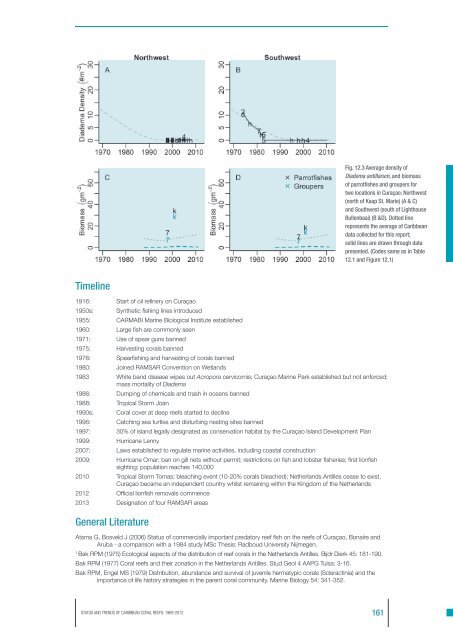Jackson2013-Status and Trendsof Caribbean Coral Reefs
Jackson2013-Status and Trendsof Caribbean Coral Reefs.pdf
Jackson2013-Status and Trendsof Caribbean Coral Reefs.pdf
You also want an ePaper? Increase the reach of your titles
YUMPU automatically turns print PDFs into web optimized ePapers that Google loves.
Fig. 12.3 Average density of<br />
Diadema antillarum, <strong>and</strong> biomass<br />
of parrotfishes <strong>and</strong> groupers for<br />
two locations in Curaçao: Northwest<br />
(north of Kaap St. Marie) (A & C)<br />
<strong>and</strong> Southwest (south of Lighthouse<br />
Bullenbaai) (B &D). Dotted line<br />
represents the average of <strong>Caribbean</strong><br />
data collected for this report;<br />
solid lines are drawn through data<br />
presented. (Codes same as in Table<br />
12.1 <strong>and</strong> Figure 12.1)<br />
Timeline<br />
1916: Start of oil refinery on Curaçao<br />
1950s: Synthetic fishing lines introduced<br />
1955: CARMABI Marine Biological Institute established<br />
1960: Large fish are commonly seen<br />
1971: Use of spear guns banned<br />
1975: Harvesting corals banned<br />
1976: Spearfishing <strong>and</strong> harvesting of corals banned<br />
1980: Joined RAMSAR Convention on Wetl<strong>and</strong>s<br />
1983 White b<strong>and</strong> disease wipes out Acropora cervicornis; Curaçao Marine Park established but not enforced;<br />
mass mortality of Diadema<br />
1986: Dumping of chemicals <strong>and</strong> trash in oceans banned<br />
1988: Tropical Storm Joan<br />
1990s: <strong>Coral</strong> cover at deep reefs started to decline<br />
1996: Catching sea turtles <strong>and</strong> disturbing nesting sites banned<br />
1997: 30% of isl<strong>and</strong> legally designated as conservation habitat by the Curaçao Isl<strong>and</strong> Development Plan<br />
1999: Hurricane Lenny<br />
2007: Laws established to regulate marine activities, including coastal construction<br />
2009: Hurricane Omar; ban on gill nets without permit; restrictions on fish <strong>and</strong> lobster fisheries; first lionfish<br />
sighting; population reaches 140,000<br />
2010 Tropical Storm Tomas; bleaching event (10-20% corals bleached); Netherl<strong>and</strong>s Antilles cease to exist,<br />
Curaçao became an independent country whilst remaining within the Kingdom of the Netherl<strong>and</strong>s<br />
2012 Official lionfish removals commence<br />
2013 Designation of four RAMSAR areas<br />
General Literature<br />
Atsma G, Bosveld J (2006) <strong>Status</strong> of commercially important predatory reef fish on the reefs of Curaçao, Bonaire <strong>and</strong><br />
Aruba - a comparison with a 1984 study MSc Thesis: Radboud University Nijmegen.<br />
1<br />
Bak RPM (1975) Ecological aspects of the distribution of reef corals in the Netherl<strong>and</strong>s Antilles. Bijdr Dierk 45: 181-190.<br />
Bak RPM (1977) <strong>Coral</strong> reefs <strong>and</strong> their zonation in the Netherl<strong>and</strong>s Antilles. Stud Geol 4 AAPG Tulsa: 3-16.<br />
Bak RPM, Engel MS (1979) Distribution, abundance <strong>and</strong> survival of juvenile hermatypic corals (Scleractinia) <strong>and</strong> the<br />
importance of life history strategies in the parent coral community. Marine Biology 54: 341-352.<br />
STATUS AND TRENDS OF CARIBBEAN CORAL REEFS: 1969-2012<br />
161


















